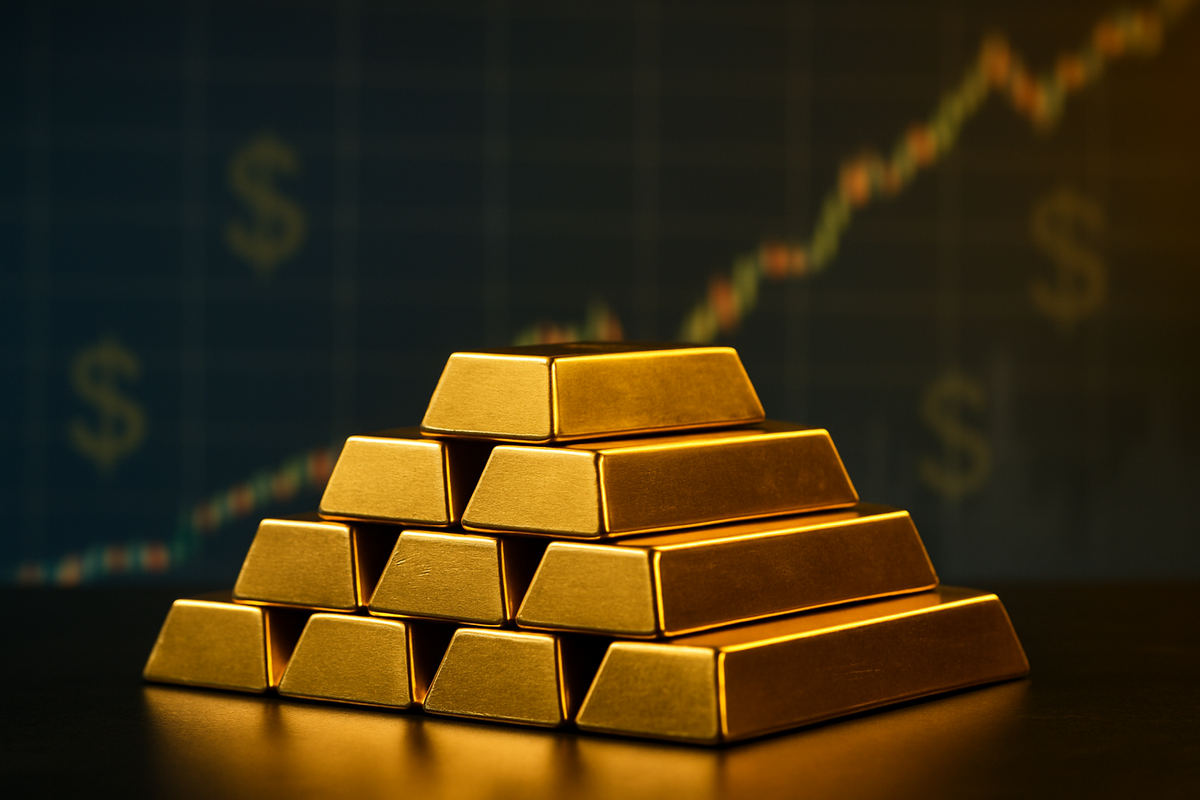
In a historic moment for financial markets, gold prices have surged past the unprecedented $4,000 per ounce threshold as of October 2025, marking a significant milestone driven by a confluence of a weakening U.S. dollar, escalating expectations for more accommodative Federal Reserve policies, and its enduring status as a "safe haven" amidst pervasive global uncertainty. This monumental ascent underscores a profound shift in investor sentiment, signaling waning confidence in traditional assets and a heightened demand for tangible stores of value in an increasingly volatile economic landscape.
The immediate implications are far-reaching, reverberating across investment portfolios, central bank strategies, and the broader economic outlook. Investors holding gold, whether through physical bullion or gold-backed instruments, are witnessing substantial gains, validating the precious metal's role as the top-performing major asset of the year. This surge is intensifying a "fear premium" and potentially igniting a "Fear Of Missing Out" (FOMO) among those yet to enter the market, prompting significant capital reallocation as institutions and individual investors alike seek to hedge against inflation, currency debasement, and geopolitical risks.
The Golden Rush: A Detailed Account of an Unprecedented Ascent
The journey to $4,000 an ounce has been a meticulously watched saga, culminating in a dramatic acceleration through late 2024 and into 2025. The initial momentum was largely fueled by persistent inflation concerns following post-pandemic fiscal stimuli and a gradual but consistent weakening of the U.S. dollar against major currencies. As global economic growth showed signs of fragility, central banks, particularly in emerging markets, began aggressively accumulating gold, diversifying their reserves away from dollar-denominated assets. This strategic pivot, driven by geopolitical tensions and a desire for greater financial autonomy, provided a robust demand floor for gold prices.
A pivotal turning point arrived with growing clarity regarding the Federal Reserve's monetary policy trajectory. Despite earlier hawkish stances, by mid-2025, market expectations solidified around a resumption of an easing cycle, with multiple rate cuts anticipated. Lower interest rates inherently reduce the opportunity cost of holding non-yielding assets like gold, making it a more attractive investment. This dovish pivot by the Fed, perceived by many as a response to slowing economic activity and persistent, albeit stubborn, inflation, significantly weakened the dollar further, making gold more affordable for international buyers and supercharging demand. Key players in this rally include not just individual investors and hedge funds, but also major central banks like the People's Bank of China and the Reserve Bank of India, whose sustained buying has been a critical underpinning. Initial market reactions have seen a surge in precious metals mining stocks and related ETFs, while some analysts caution about potential volatility and profit-taking after such a rapid ascent.
Corporate Fortunes: Winners and Losers in the Gold Boom
The historic surge in gold prices to over $4,000 per ounce creates a distinct landscape of winners and losers within the public markets, primarily impacting the mining sector, investment vehicles, and industries reliant on gold as a raw material.
The Winners:
Gold mining companies are the most obvious and significant beneficiaries. Higher gold prices directly translate into expanded profit margins, increased cash flows, and stronger balance sheets. This makes previously uneconomical ore deposits viable, encouraging investment in exploration and production. Major players like Barrick Gold Corporation (NYSE: GOLD) and Newmont Corporation (NYSE: NEM) are poised for substantial gains, as their operational leverage amplifies the impact of rising prices on their bottom lines. Smaller, mid-tier producers and explorers also stand to benefit immensely, potentially seeing their projects become more attractive for development or acquisition. Precious metals-focused Exchange-Traded Funds (ETFs) such as the SPDR Gold Shares (NYSEARCA: GLD) and the iShares Gold Trust (NYSEARCA: IAU) have experienced massive inflows, reflecting broad investor interest in gaining exposure to gold's upward trajectory. Companies specializing in gold streaming and royalties, like Franco-Nevada Corporation (NYSE: FNV), also see their revenue streams swell proportionally with higher gold prices, offering a diversified way to profit from the boom without direct mining operations.
The Potential Losers (or those facing challenges):
While fewer direct "losers" emerge from a gold price surge, certain sectors and companies may face indirect headwinds. Industries that rely on gold as a key input, such as luxury jewelry manufacturers or high-tech electronics companies using gold in components, might see increased production costs. Companies like Tiffany & Co. (NYSE: TIF), a subsidiary of LVMH, or various electronics manufacturers, could face pressure on their margins if they cannot pass on these higher costs to consumers. Furthermore, a significantly weaker U.S. dollar, which is a key driver of gold's rally, can make imports more expensive for U.S.-based companies and consumers, potentially fueling broader inflationary pressures that could dampen consumer spending on non-essential goods. In a scenario where gold's rise signifies broader economic instability, companies heavily reliant on stable economic conditions or discretionary spending might face reduced demand for their products and services.
Broader Implications: A Shift in the Financial Paradigm
The unprecedented surge in gold prices to over $4,000 an ounce is more than just a market event; it signifies a deeper, systemic shift in the global financial paradigm, with far-reaching implications for industry trends, regulatory frameworks, and international finance. This event firmly entrenches gold's role as the paramount safe-haven asset, particularly as investor confidence in traditional fiat currencies and government bonds wanes. It aligns with a broader trend of de-dollarization among central banks and a growing recognition of tangible assets as hedges against monetary policy uncertainties and geopolitical fragmentation.
The ripple effects are profound. Competitors in the alternative asset space, such as certain cryptocurrencies that market themselves as "digital gold," may face renewed scrutiny regarding their stability and true safe-haven credentials compared to gold's millennia-long track record. Partners in the financial ecosystem, particularly those offering wealth management and advisory services, will likely see increased demand for gold-backed products and strategies. Regulatory bodies may begin to assess the stability of financial institutions with significant exposure to or reliance on traditional currency assets, potentially prompting new guidelines for reserve diversification. Historically, gold surges have often coincided with periods of significant economic stress or geopolitical upheaval, such as the oil crises of the 1970s or the global financial crisis of 2008. This current rally, however, distinguishes itself by its magnitude and the simultaneous drivers of weakening dollar, anticipated Fed easing, and persistent geopolitical instability, suggesting a more complex and potentially prolonged period of elevated gold prices.
The Road Ahead: Navigating a Golden Future
The path forward following gold's historic breach of the $4,000 mark is rife with both opportunities and challenges, demanding strategic pivots and careful navigation from investors and institutions alike. In the short term, the market may experience periods of consolidation or profit-taking, as some investors lock in gains. However, the underlying drivers—a weaker dollar, dovish Fed expectations, and ongoing global uncertainties—are likely to provide continued support for gold prices, suggesting that this rally has more room to run. Analysts are already discussing targets well beyond $4,000, with some forecasting $4,500 or even $5,000 per ounce within the next 12-18 months, especially if inflation proves stickier than anticipated or if geopolitical tensions escalate further.
Long-term possibilities include a sustained re-evaluation of gold's role in diversified portfolios, leading to a permanent increase in institutional allocations. Central banks are expected to continue their gold accumulation, solidifying its position as a critical component of national reserves. Market opportunities will emerge for innovative financial products that offer diversified exposure to precious metals, as well as for gold mining companies to expand their operations and exploration efforts. Conversely, challenges may arise from potential regulatory interventions aimed at stabilizing currency markets or managing inflationary pressures. Investors should prepare for increased market volatility, but also recognize the potential for gold to act as a crucial portfolio stabilizer during periods of broader market turbulence. Potential scenarios range from a continued steady ascent, fueled by ongoing monetary easing and geopolitical concerns, to more volatile swings if economic data shifts or central bank policies diverge from current expectations.
A Golden Epoch: Key Takeaways and Future Outlook
The surge of gold prices beyond $4,000 per ounce marks a watershed moment in financial history, signaling a new epoch where the precious metal's intrinsic value as a safe haven and inflation hedge is more pronounced than ever. The confluence of a weakening U.S. dollar, the Federal Reserve's anticipated dovish stance, and persistent global uncertainties has created a potent cocktail, driving unprecedented demand for gold. This event underscores a significant shift in investor psychology, moving away from an exclusive reliance on traditional growth assets towards a greater appreciation for wealth preservation and stability.
Moving forward, the market is poised for continued interest in gold, with its trajectory heavily influenced by central bank policies, inflation data, and geopolitical developments. Investors should watch closely for any shifts in the Federal Reserve's rhetoric or actions, as well as the dollar's strength, which will remain critical determinants of gold's short-term movements. The sustained buying by central banks and institutional investors provides a strong foundation, suggesting that gold's elevated status is not a fleeting phenomenon but rather a reflection of deeper structural changes in the global financial landscape. This golden surge serves as a powerful reminder of diversification's importance and gold's enduring role as a beacon of stability in an unpredictable world.
This content is intended for informational purposes only and is not financial advice





